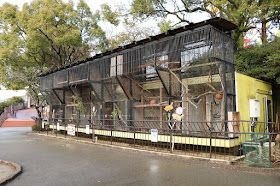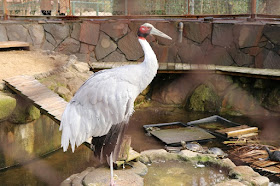Omuta
City Zoo is a compact facility built on about 4.4 hectares wrapped around the
perimeter of Enmei Park. After starting
from the entrance, visitors walk a path that guides them past all of the
exhibits in the zoo. Because the zoo grounds
wrap around the hilly and heavily forested terrain, and also because signs
guide visitors ever gradually to the further end of the zoo, the zoo seems a
lot larger than its actual land area. According
to information on a Omuta City Zoo homepage, this facility houses about 271
individual animals representing 55 species.
Since there was basically only one road in and out of the zoo, I will
discuss the exhibits in the order that they are naturally encountered.
Squirrel Monkey Kingdom
This area was definitely one
of the most engaging of Omuta’s enclosures.
It was comprised of a small building housing the monkeys’ indoor
quarters surrounded by a small orchard enclosed by a tent-shaped netting.
The
Squirrel monkeys moved about this area freely, and visitors could observe them
at a distance of only 2 or 3 meters.
This was the kind of enclosure where visitors can end up spending an
hour or two watching the cute little furries.
At the time of my visit, there were 6 squirrel monkees. There was also a sloth housed in the small
building.
Spotted Seal
This enclosure was a simple
pool. For some reason, the water was
kept at a very shallow depth, it was so shallow on one end that the seal could
sleep with it’s head above the water line.
Small monkeys
This
“cage-and-concrete” style enclosure housed Tufted Capuchins and Pig-tailed
macaques. Each monkey’s compartment
appeared small. Unlike the Squirrel
monkey area, visitors seemed to spend little time observing this exhibit.
Japanese Black Bear
This
small cage-and concrete exhibit seemed very small considering the size of the
resident bear. Not much else can be said
about this enclosure.
Turtles and cranes
This
hexagon-shaped cage housed a number of turtles and a few birds. For the largest bird, a Japanese crane, the
space seemed somewhat small.
Bird Aviary
This
walk-in aviary, a large tent-shaped netted enclosure, was quite large. At its highest point, it appeared to be the
height of a 6-story building. After
walking around this spacious enclosure, I thought it would be nice if the
Japanese crane from the hexagonal cage were brought to live here.
Entrance
to aviary.
Walkway
Common
peafowl
Grey
crowned crane
Large
inner area
High
roof
Mandrill cage
This
enclosure was similar to the bear enclosure: small, plain, uninteresting.
Domesticated animals
This
section was dedicated to domesticated animals: miniature pigs, sheep, and goats. Visitors could get very close to the animals,
but I didn’t check whether visitors were allowed to touch the animals.
Mouflon and Llamas
This
section had mouflon sheep, llamas, and emus in large farm-style pens. There was also a small hut-type structure
with a fox and a porcupine.
Big Cats
This
structure housing the exhibits for the lions and the white tiger appeared to be
the focal point for this zoo. Not only
was it located in approximately the geographic middle of the zoo, it seemed to
exert a gravitational pull on visitors walking past it.
There
were homemade signs and props explaining the characteristics of the lions and
their behaviours.
The
first enclosure in this structure housed a female lion.
A
sleeping female lion.
This
middle enclosure housed the lion male.
For
this middle area, there were glass windows through which to view the male lion.
The
glass windows could have used some cleaning.
This
third enclosure in this structure housed an 18-year old female white
tiger. According to the zoo’s webpage,
this tiger came to Omuta City Zoo from another zoo which went out of business.
This
white tiger appeared to have crossed eyes, a condition that is said to be
common among white tigers, and a possible indication that the tiger may have
been bred from closely related bloodlines.
Bridge
As
I followed the zoo path deeper and deeper into the interior of the zoo, I came
upon an area where a bridge connected two sections of the zoo separated by a
valley and vehicle access road.
The
bridge was decorated with cast emblems of large charismatic animals.
After
crossing the bridge, I came upon a large clearing with four animal enclosures. There was also a tented area in the middle of
the clearing with places to sit.
The
first of the enclosures appeared to have been original used as an elephant exhibit. It was now home to Capybaras.
There
was a Giraffe exhibit which actually had a fair amount of grassy area.
There
was a Red panda house.
According
to the signage in front of the panda house, I think this particular Red panda
was about 17 years old.
The
fourth enclosure in this area was inhabited by Eastern Grey Kangaroos. This was a walk-in type of exhibit which
allowed visitors to get within breathing distance of the animals.
The
kangaroos were all leisurely snacking on cut tree branch leaves.
Very
cute
Visitors
could get very close to the animals.
Sometimes
the kangaroos came very close to the visitor.
Kangaroo
design on manhole cover.
Close encounters
With
respect to interactions with animals, this zoo allowed visitors to handle
guinea pigs.
Designated
times for guinea pig encounters.
Other attractions and
facilities
This building housed a lecture
hall.
Food and Souvenirs
There were two food stands in
this zoo. The one in the below photo was
located between the Red panda and Grey Kangaroo exhibits.
Some
of the prices for the more popular items:
Yakisoba
450 yen
Takoyaki
400 yen
Karaage
250 yen
Fried
potato 250 yen
Onigiri
250 yen
Udon
400 yen
Soft
cream 300 yen
This
second snack stand was located near the entrance to the zoo. It had almost the same menu as the previous
snack bar. There was also a small
selection of souvenirs for sale.
Getting There
I
visited this zoo by private car, so I cannot accurately speak to access via
public transportation. According to
information on the internet, it is a 15 or 20 minute walk from JR Omuta station. Because of the hilly nature of the area
surrounding the zoo, I would recommend taking a taxi. Admission to the zoo was 370 yen for adults,
210 yen for high school students, 80 yen for “children” (presumably children up to intermediate school), and free for children
under 3 year old.
(Note:
All photos in this post were taken during a visit made on February 19, 2019. The comments in this post are based on
observations made at that time.
Conditions may have since changed.
Please check it out for yourself!)




































































